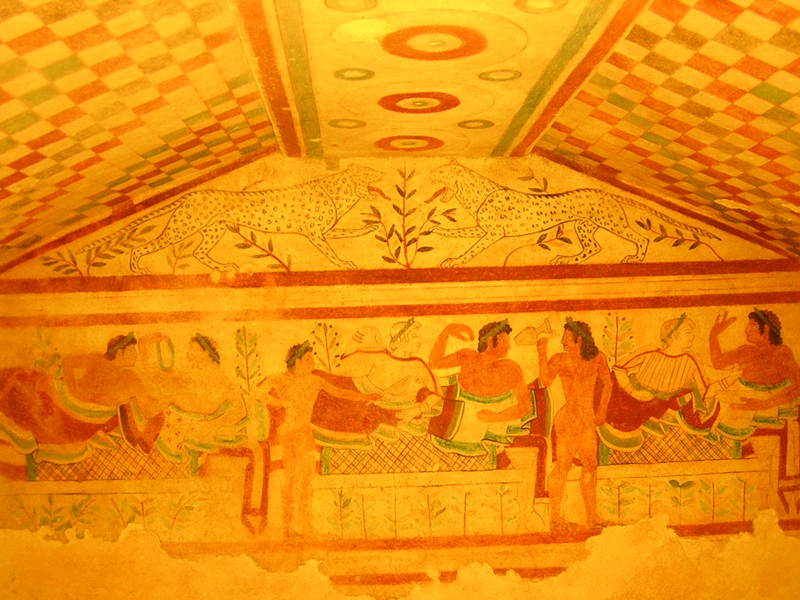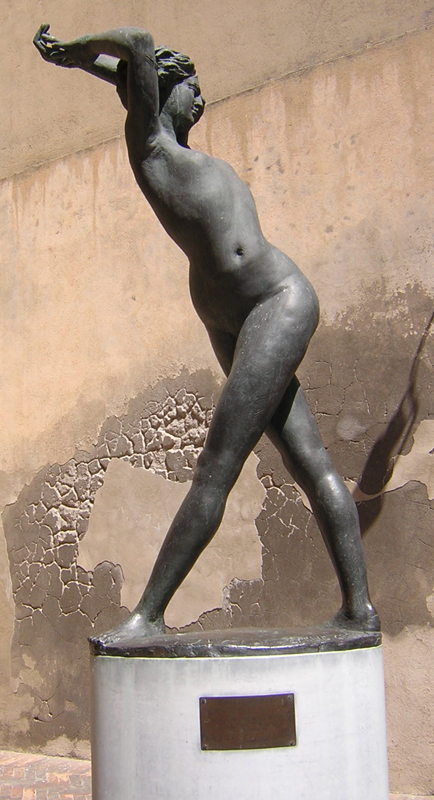|
|
 |
|
The Feasts of the Dead |
|
written
by leahs2 / 08.30.2005 |
|
|
| |
Part 1: |
| |
| |

|
| My photograph on-site. |
| Tomb of the Leopards |
|
| |
|
In "Etruscan Places," Lawrence focuses overwhelmingly on Etruscan death art that is a celebration of life. The tombs and paintings are for those that have died, yet they show the joy and fluidity of life. “And death to the Etruscan, was a pleasant continuance of life, with jewels and wine and flutes playing for the dance. . . It was just a natural continuance of the fullness of life.” (109) When visiting the tombs he describes in detail the festivities. For example, the Tomb of the Leopards “is a charming, cosy little room;” the tomb itself is welcoming. Despite the years of wear since the tombs were created, “still the paintings are fresh and alive: the ochre-reds and blacks and blues and blue-green are curiously alive and harmonious on the creamy yellow walls.” (135) Vibrant colors and energetic descriptions of scenes are common. Lawrence seems to be looking for the joy of life that surrounds these people even in their death; a circumstance he must also hope to be true in his own death. When facing death and the lack of knowledge of what follows, Lawrence chooses to hope that it is similar to the best of life. He states that “It all seems so gay and light. Yet there is a certain weight, or depth of significance that goes beyond aesthetic beauty.” (137) He knows festive scenes were not selected by chance, but are the genuine wish and blessing for the dead to have a peaceful and joyous life in death.
The life-joy picture Lawrence paints of the ancient Etruscans indicates Lawrence’s current focus on joy in life as he approaches death. His extreme admiration for the Etruscan way of life implies either recognition or regret that his life was not full of the same freedom and joy. “And in the full, dark, handsome, jovial faces surely you see the luster still of the life-loving Etruscans! There are some level Greek eyebrowsn. But surely there are other vivid, warm faces still jovial with Etruscan vitality, beautiful with the mystery of the unrifled ark, rip with the phallic knowledge and the Etruscan carelessness!” (113) Lawrence portrays the Etruscans as a vibrant civilization against the traditional narrative of a cruel, primitive, group of people. “It is there nearly always in Etruscan things, the naturalness verging on the commonplace, but usually missing it, and often achieving an originality so free and bold, and so fresh, that we, who love convention and things ‘reduced to a norm’, call it a bastard art, and commonplace.” (130) In “Etruscan Places,” Lawrence rewrites the history of the Etruscan people: their art is given value and their culture is appreciated for its vibrancy. In one of Lawrence’s final pieces of writing, he gives back life to the Etruscan people in the picture he creates for the reader, and therefore in the modern conception of the Etruscan peoples. As a final act this may stand as atonement for his own lack of joy in life; or it may be his creation of vibrant joy for readers to see in the Etruscans; or a hopeful narrative of his coming experience in death.
|
| |
|
| |
|
| |
Part 2: |
| |
| |

|
| My photograph on-site. |
| Lady Statue |
| Statue outside the Museum of Tarquinia. Dmilio Greco, la scultura e dono del maestro. Tarquinia, October 13, 1990. |
| |
|
The dominant image that Lawrence creates in his writing is the life-joy of the Etruscans through his plentiful and vivid descriptions of various frescos in the tombs. See the above paragraph for in-depth analyses of these images.
From my visit to Tarquinia, I bring back the image of the joyfully festive frescos in the tombs. I see this in the strong, vital, sweeping strokes of the moving bodies in the scenes. The Tomba dei Leopardi has stuck with me. Men were feasting and a festive, happy, vibrant culture was implied. These frescos were in excellent shape: the dance was made in turquoise, rustic red, light beige, and stone colors. The entire scene created an aesthetically soothing and pleasing framework. Festivities and dancers were on the main walls outlined by bold and thin lines. Above on the slanted ceiling were checkered patterns. The two leopards face each other with tongues unfurled. The painting strokes were bold lines to create 2D, geometric figures. However, the circular patterns on the center-ceiling mirror the small circles on the body of the leopards and the crowns on the heads of the feasting men. Festive life stays with the Etruscans in death.
As with Lawrence, I felt that “gradually the underworld of the Etruscans becomes more real than the above day of the afternoon. One begins to live with the painted dancers and feasters and mourners, and to look eagerly for them.” (138) I scurried from tomb to tomb, unhappy to be outside in the dry, dusty, hot air and always glad to descend into a tunnel of cooling darkness and fresco color. Sitting at the Tomb of the Leopard, I felt that if I waited there long enough, or perhaps if I half-dozed, the tombs would speak to me. I would hear the story of the Etruscan whom was once buried in this tomb; the cooling stone walls wanted to tell me something. This civilization is known through its care of the dead and its images of festivities, war, dancing, sex, art, and nature. I desire to travel back in history, and if I wait long enough I will seep into history and join the Etruscans feasting.
The images of the dancers I carry in my mind are my search to find movement and bodily form in all I see. The desire to feast with the Etruscans is my hope that history is not lost but can be accessed by spending time in the tombs, actively engaging my thoughts in their frescoes, and being genuinely intrigued by their culture.
|
| |
|
| |
|
|
 |
|


